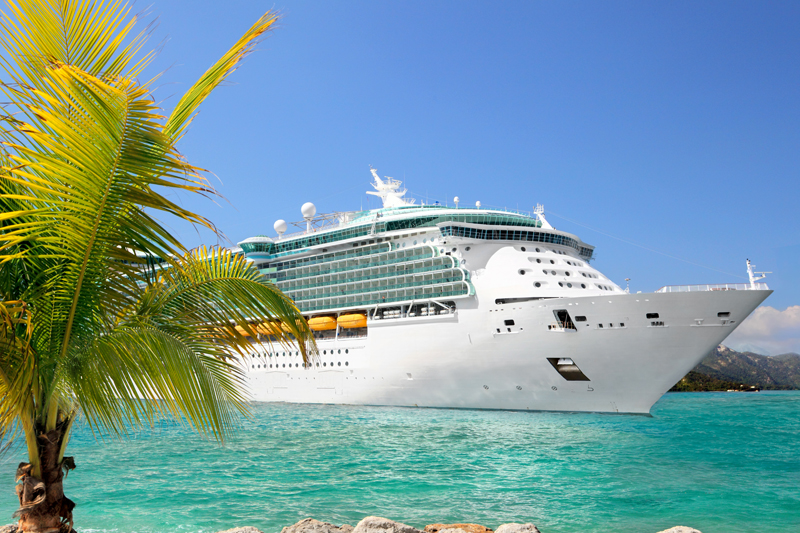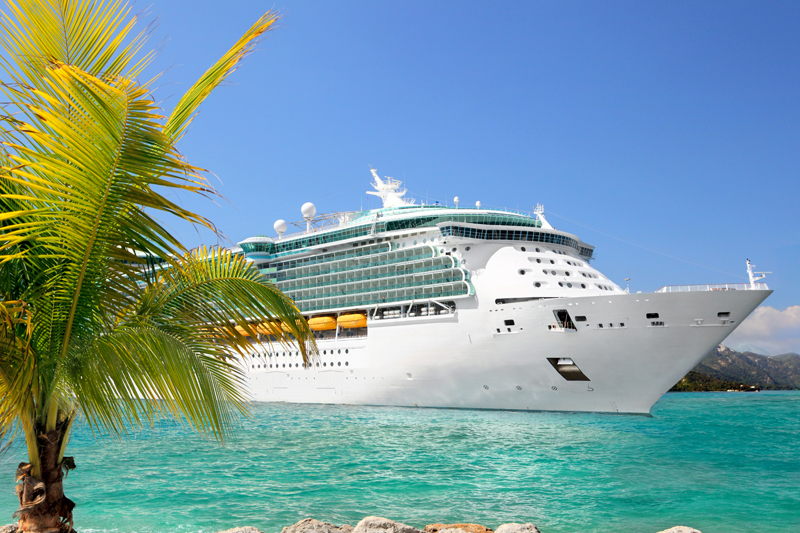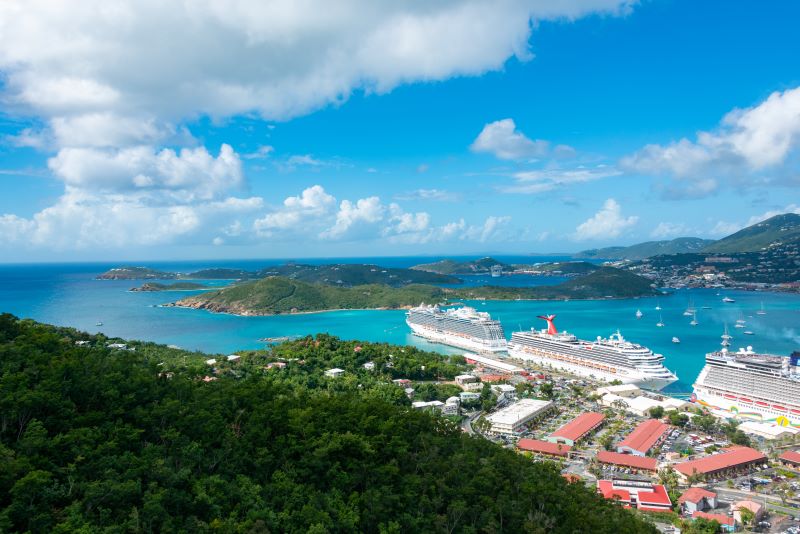10 Tips For Cruising During Hurricane Season

There are a number of great reasons to take a cruise during hurricane season, which officially stretches from June 1 to November 30. Cruise rates can be discounted significantly, making this one of the cheapest times of the year to travel. In addition, those who want to avoid having lots of children on their cruise find September through early November to be a good time to sail. Tropical ports of call in the Caribbean and Mexico also tend to be less crowded during this time period.
While cruise prices during hurricane season are enticing, there are other important factors to consider as well. Tropical storms and hurricanes can result in radically changed cruise itineraries with little notice. During this period, an Eastern Caribbean itinerary can suddenly become a modified Western Caribbean cruise (or vice versa) due to the looming presence of a hurricane. Heavy rain and weather issues can also impact flights and activities in both embarkation ports and ports of call. Rough seas can be a factor as well.
Although bad weather is a risk, many vacationers have a fantastic time on hurricane season cruises. It's just important to plan accordingly. If you’re considering taking a cruise during hurricane season, here are ten tips:
1. Consider What’s Important Before Booking. If you’re thinking about taking a cruise during hurricane season, carefully weigh the aspects of cruising that are most important to you. Vacationers who select cruises solely on the basis of the ship’s itinerary should think twice about cruising from August through early November. If a hurricane develops, it's possible that your ship will remain at sea or be re-routed to alternate ports to avoid bad weather. Compensation for missed ports may be offered by your cruise line, but it’s likely to be minimal at best. In addition, those who are prone to seasickness or are not particularly flexible might wish to avoid these months as well. It can be difficult when vacation expectations are not met and there's little recourse. On the other hand, hurricane season is an excellent choice for budget-conscious travelers who view the ship as their primary vacation destination. Itineraries tend to be less important to these travelers, allowing them to enjoy their cruise vacation no matter where the ship sails.
2. Review Available Itineraries. Peak hurricane periods for the Eastern Caribbean, the Bahamas and Bermuda are August through late September, although a number of major storms have formed much earlier and later in the season. Hurricanes and tropical storms are more likely to develop in the Western Caribbean from mid-August through early November. Cruise itineraries can be changed significantly if tropical storms appear. Cruisers can often minimize their hurricane risk by choosing a Southern Caribbean itinerary during hurricane season, particularly one focusing on Aruba, Bonaire and Curacao. These islands are considered to be at the outer edge of the hurricane belt and are not often affected by major storms. If beaches and warm weather aren’t particularly important, check out the many other cruise itineraries available during hurricane season.
3. Choose The Right Ship. It’s wise for cruise shoppers to consider onboard amenities when choosing a ship for a hurricane season cruise. Look carefully at the amenities and entertainment available on each ship, paying special attention to indoor pools, activities and entertainment options that can be enjoyed even in bad weather. Newer or recently refurbished ships tend to have some of the coolest pools, spas, entertainment, specialty dining options and other features. Research what’s available and consider consulting with a good cruise travel agent to get their insights.
4. Shop For Flights Carefully. Flights can often be affected by bad weather and flight delays during hurricane season. Take a direct flight or leave plenty of time for connections. Direct flights can be more expensive, but that’s not always the case. Use a good travel agent or book your flights immediately after you purchase your cruise for the best results. If connecting flights are mandatory for your cruise, make sure to allow plenty of time for connections. While a 40-50 minute connecting time between flights is often considered to be “legal” by the airlines, it will give you little cushion if there’s a weather or mechanical delay. Play it safe and allow about two hours or so for connections. This is particularly true when traveling with children, as it often takes a longer time to get from gate to gate.
5. Plan To Arrive A Day Early. This is good advice for any time of the year, but it’s particularly important during hurricane season. Arriving a day before embarkation provides cushion time to guard against any severe weather or mechanical problems that could interfere with your flight. This involves the additional expense of a hotel room, but avoiding embarkation day stress and possibly missing your ship is well worth the cost. Some experienced cruisers also build in an extra day in their embarkation port post-cruise, just in case arrival is delayed due to issues getting back into port during a storm.
6. Use a Travel Agent. Working with a good travel agent is helpful for any cruise, since they can help travelers select the best ship, stateroom and flights for their cruise vacation. During hurricane season, travel agents can become even more important. Agents can provide valuable assistance such as keeping their clients posted on itinerary changes and helping them reschedule flights if a storm disrupts airline schedules or their ship’s planned sailing dates.
7. Purchase Trip Insurance. It’s smart to purchase trip insurance for cruises during hurricane season and any time of the year, but shop carefully. A good cruise insurance package will protect against travel and flight delays, flight cancellations, travel interruption, and trip cancellation due to a hurricane if your policy includes it. Make sure to research your policy very carefully before purchasing to understand what’s included and what’s not, however. Travel insurance policies are not created equal, so call your potential travel insurance company and ask about coverage and hurricane protection. Cancel For Any Reason policies are also available, which will generally reimburse 50-75% of pre-paid, non-refundable trip costs if you decide not to go on your trip due to the chance of bad weather or other non-covered reasons. Also remember that travel insurance only covers events that have not been already predicted, so purchase your trip insurance far in advance. Once weather forecasters have indicated that a tropical storm is possible, it’s too late to purchase trip insurance for hurricane coverage. In addition, changes in cruise itineraries are not covered by travel insurance. While cruise lines may provide some compensation for missed ports and other hurricane-related events, it may be minimal.
8. Research Shore Excursion Cancellation Policies. Carefully consider shore excursion cancellation policies when booking during hurricane season. Your cruise line and many tour operators will provide full excursion refunds if the ship does not make it into port. Smaller tour operators may have different refund policies, however, so make sure to inquire in writing before booking.
9. Monitor Weather Forecasts. If you’ve planned a cruise during hurricane season, check the weather forecasts as your trip departure date gets closer. Create airline notifications for each of your flights in case of delays or cancellations. If it appears that a storm may affect your travel plans, check with your airline to find out what options are available. These may include departing a day early if not doing so already or leaving on an earlier flight. Be proactive – don’t wait for the airlines to contact you. As your sailing date approaches, check your email regularly and monitor your cruise line’s website to be aware of any potential changes to your itinerary. This is particularly important during hurricane season. If you are driving to your embarkation port, park your car on a high floor towards the interior of the parking garage and take any valuables out of the car just in case. In addition, check the weather forecast for your home area to see if severe weather may be coming your way while you’re gone.
10. Pack Wisely. Pack plenty of rain gear, just in case. It’s sure to come in handy if bad weather occurs. While your ship's captain will work hard to deliver the most optimal guest experience, sometimes rough seas may occur. Plan accordingly and bring along your favorite seasickness remedy, too. It always helps to pack a positive attitude as well. While tropical storms may be possible, the weather could turn out to be fantastic for your hurricane season cruise. If you make your decisions wisely and stay flexible, you're likely to have a good time no matter what happens.
While cruise prices during hurricane season are enticing, there are other important factors to consider as well. Tropical storms and hurricanes can result in radically changed cruise itineraries with little notice. During this period, an Eastern Caribbean itinerary can suddenly become a modified Western Caribbean cruise (or vice versa) due to the looming presence of a hurricane. Heavy rain and weather issues can also impact flights and activities in both embarkation ports and ports of call. Rough seas can be a factor as well.
Although bad weather is a risk, many vacationers have a fantastic time on hurricane season cruises. It's just important to plan accordingly. If you’re considering taking a cruise during hurricane season, here are ten tips:
1. Consider What’s Important Before Booking. If you’re thinking about taking a cruise during hurricane season, carefully weigh the aspects of cruising that are most important to you. Vacationers who select cruises solely on the basis of the ship’s itinerary should think twice about cruising from August through early November. If a hurricane develops, it's possible that your ship will remain at sea or be re-routed to alternate ports to avoid bad weather. Compensation for missed ports may be offered by your cruise line, but it’s likely to be minimal at best. In addition, those who are prone to seasickness or are not particularly flexible might wish to avoid these months as well. It can be difficult when vacation expectations are not met and there's little recourse. On the other hand, hurricane season is an excellent choice for budget-conscious travelers who view the ship as their primary vacation destination. Itineraries tend to be less important to these travelers, allowing them to enjoy their cruise vacation no matter where the ship sails.
2. Review Available Itineraries. Peak hurricane periods for the Eastern Caribbean, the Bahamas and Bermuda are August through late September, although a number of major storms have formed much earlier and later in the season. Hurricanes and tropical storms are more likely to develop in the Western Caribbean from mid-August through early November. Cruise itineraries can be changed significantly if tropical storms appear. Cruisers can often minimize their hurricane risk by choosing a Southern Caribbean itinerary during hurricane season, particularly one focusing on Aruba, Bonaire and Curacao. These islands are considered to be at the outer edge of the hurricane belt and are not often affected by major storms. If beaches and warm weather aren’t particularly important, check out the many other cruise itineraries available during hurricane season.
3. Choose The Right Ship. It’s wise for cruise shoppers to consider onboard amenities when choosing a ship for a hurricane season cruise. Look carefully at the amenities and entertainment available on each ship, paying special attention to indoor pools, activities and entertainment options that can be enjoyed even in bad weather. Newer or recently refurbished ships tend to have some of the coolest pools, spas, entertainment, specialty dining options and other features. Research what’s available and consider consulting with a good cruise travel agent to get their insights.
4. Shop For Flights Carefully. Flights can often be affected by bad weather and flight delays during hurricane season. Take a direct flight or leave plenty of time for connections. Direct flights can be more expensive, but that’s not always the case. Use a good travel agent or book your flights immediately after you purchase your cruise for the best results. If connecting flights are mandatory for your cruise, make sure to allow plenty of time for connections. While a 40-50 minute connecting time between flights is often considered to be “legal” by the airlines, it will give you little cushion if there’s a weather or mechanical delay. Play it safe and allow about two hours or so for connections. This is particularly true when traveling with children, as it often takes a longer time to get from gate to gate.
5. Plan To Arrive A Day Early. This is good advice for any time of the year, but it’s particularly important during hurricane season. Arriving a day before embarkation provides cushion time to guard against any severe weather or mechanical problems that could interfere with your flight. This involves the additional expense of a hotel room, but avoiding embarkation day stress and possibly missing your ship is well worth the cost. Some experienced cruisers also build in an extra day in their embarkation port post-cruise, just in case arrival is delayed due to issues getting back into port during a storm.
6. Use a Travel Agent. Working with a good travel agent is helpful for any cruise, since they can help travelers select the best ship, stateroom and flights for their cruise vacation. During hurricane season, travel agents can become even more important. Agents can provide valuable assistance such as keeping their clients posted on itinerary changes and helping them reschedule flights if a storm disrupts airline schedules or their ship’s planned sailing dates.
7. Purchase Trip Insurance. It’s smart to purchase trip insurance for cruises during hurricane season and any time of the year, but shop carefully. A good cruise insurance package will protect against travel and flight delays, flight cancellations, travel interruption, and trip cancellation due to a hurricane if your policy includes it. Make sure to research your policy very carefully before purchasing to understand what’s included and what’s not, however. Travel insurance policies are not created equal, so call your potential travel insurance company and ask about coverage and hurricane protection. Cancel For Any Reason policies are also available, which will generally reimburse 50-75% of pre-paid, non-refundable trip costs if you decide not to go on your trip due to the chance of bad weather or other non-covered reasons. Also remember that travel insurance only covers events that have not been already predicted, so purchase your trip insurance far in advance. Once weather forecasters have indicated that a tropical storm is possible, it’s too late to purchase trip insurance for hurricane coverage. In addition, changes in cruise itineraries are not covered by travel insurance. While cruise lines may provide some compensation for missed ports and other hurricane-related events, it may be minimal.
8. Research Shore Excursion Cancellation Policies. Carefully consider shore excursion cancellation policies when booking during hurricane season. Your cruise line and many tour operators will provide full excursion refunds if the ship does not make it into port. Smaller tour operators may have different refund policies, however, so make sure to inquire in writing before booking.
9. Monitor Weather Forecasts. If you’ve planned a cruise during hurricane season, check the weather forecasts as your trip departure date gets closer. Create airline notifications for each of your flights in case of delays or cancellations. If it appears that a storm may affect your travel plans, check with your airline to find out what options are available. These may include departing a day early if not doing so already or leaving on an earlier flight. Be proactive – don’t wait for the airlines to contact you. As your sailing date approaches, check your email regularly and monitor your cruise line’s website to be aware of any potential changes to your itinerary. This is particularly important during hurricane season. If you are driving to your embarkation port, park your car on a high floor towards the interior of the parking garage and take any valuables out of the car just in case. In addition, check the weather forecast for your home area to see if severe weather may be coming your way while you’re gone.
10. Pack Wisely. Pack plenty of rain gear, just in case. It’s sure to come in handy if bad weather occurs. While your ship's captain will work hard to deliver the most optimal guest experience, sometimes rough seas may occur. Plan accordingly and bring along your favorite seasickness remedy, too. It always helps to pack a positive attitude as well. While tropical storms may be possible, the weather could turn out to be fantastic for your hurricane season cruise. If you make your decisions wisely and stay flexible, you're likely to have a good time no matter what happens.

Related Articles
Editor's Picks Articles
Top Ten Articles
Previous Features
Site Map
Content copyright © 2023 by Nancy Schretter. All rights reserved.
This content was written by Nancy Schretter. If you wish to use this content in any manner, you need written permission. Contact Nancy Schretter for details.






